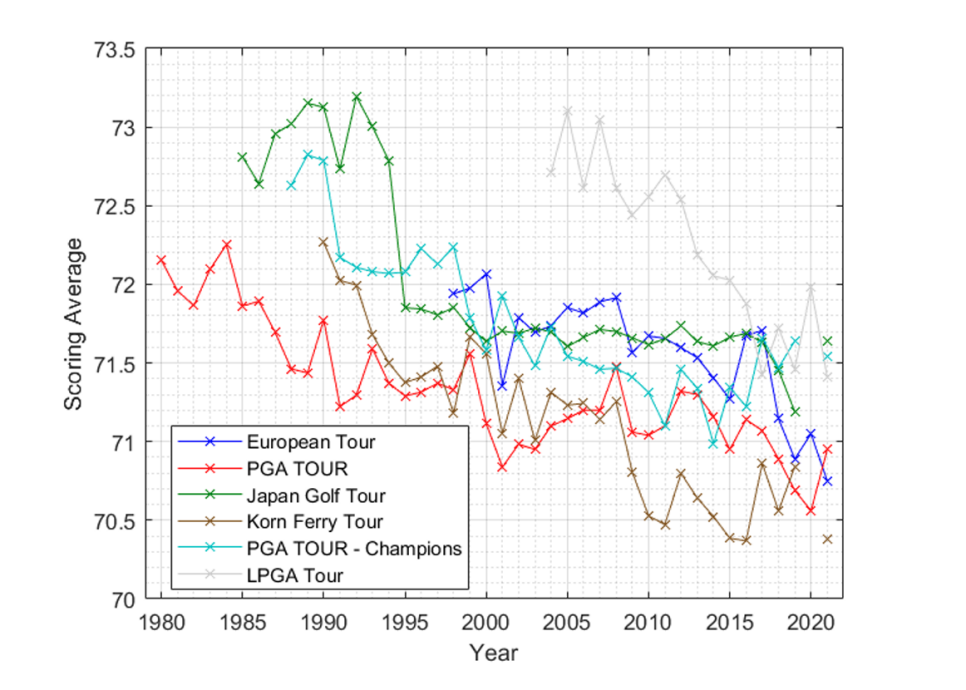Andrew Redington
By Mike Stachura
While Wednesday’s announcement that the USGA and R&A have narrowed their focus on ways to dial back distance at the elite level might have gotten all the attention, the ruling bodies also issued their annual Distance Report at the same time.
In its simplest interpretation, the Distance Report has been used to chronicle the imbalanced role distance is playing at the elite level. At first glance, this latest report may not have been the most convincing document. Year over year, driving distance on the PGA Tour, the European Tour (now DP World Tour), the Korn Ferry Tour and the Japan Golf Tour decreased in 2021 compared to 2020. And while average distances on the PGA Tour Champions, LPGA Tour and LET showed increases, each was below or just fractionally above their respective all-time highs.
But the point the ruling bodies want to make with the document is the overall trendline, which clearly has been much more upward than stable over the last 30 years. The reports use 2003 as a benchmark since that marks the first full year after the ruling bodies issued a Joint Statement of Principles that put elite driving distances on notice.
Since 2003, according to their research, the average driving distance has increased 3.2 percent from 2003-2021. Moreover, the document makes the case that the PGA Tour statistic measuring all drives (compared to the metric that only accounts for two measured holes) was up 1.5 yards to an all-time high of 289.9 yards. Still, on the measured holes on the PGA Tour, 97 percent of the shots were hit with a driver, validating that number as the best indicator of where distance truly stands.

Also, not surprisingly, the bulk of drives are getting longer, according to the report. Since 2003, the percentage of drives less than 280 yards has decreased on both the PGA Tour and European Tour, while the percentage of drives greater than 300 yards has increased. In 2003, about 40 percent of drives recorded on the PGA Tour and European Tour were 280 yards and less, while slightly more than a quarter of drives exceeded 300 yards. By 2021, those percentages had more than flipped. In 2021, less than a quarter of drives didn’t reach 280 yards, while about 43 percent were longer than 300.
The Distance Report also details data on PGA Tour clubhead speed, ball speed, launch angle and distance. Since 2003, average clubhead speed is up two mph, ball speed is up five mph, launch angle is slightly down and average spin rates also have decreased. In 2021, the average launch angle (10.5 degrees) and spin rate (2,527 rpm) were close to USGA golf ball testing averages (10 degrees, 2,520 rpm). While the average clubhead speed was 115.1 mph—about five mph short of the current clubhead speed used in the ball test—the 90th percentile for clubhead speed (120.1 mph) is now right in line with that test speed.
The Distance Report also tracks the changes in scoring average across all tours. While it, too, reflects improvement in the last 40 years, the report characterises scores showing a “slow creep downward” of .04 strokes per year since 1980. Since 2003, it shows the scoring average on the PGA Tour is essentially unchanged.

The ruling bodies’ announcement on Wednesday of new “areas of interest” included the idea of raising the test swing speed of the golf ball’s Overall Distance Standard to “at least” 125 mph in order to more closely reflect tour player swing speeds. Data from the PGA Tour may indicate that 125 is about as rare as when the ruling bodies chose to update the test to a speed of 120 mph in 2004. This year, the average of the fastest swing speed each player on tour has recorded is about 119 mph.
Thomas Pagel, the USGA’s chief governance officer, said the Overall Distance Standard has adapted to the landscape of the elite men’s game as it has developed.
“We reflected on the intent of that rule to replicate the longest-hitting golfers at the time,” he said. “We just stepped back and observed what we’re seeing at the highest level today with the longest hitters, and recognized that 120 is no longer the number that replicates that. It was really, frankly, a reflection on history, and saying, ‘Are we at another moment in time where we need to go back in and revise this?’
“As for whether 125 is enough, we may find that 125 is not enough, or we may find that 125 is a good number. But 10 years from now, we need to plan on researching and looking at further change so that we can evolve and ensure that the rule continues to model or mirror what we’re seeing the longest hitters in the game doing.”
While the trend in driving distance is clearly upward historically, the rate of increase doesn’t seem out of whack with past numbers. The PGA Tour players may be hitting it 3.6 percent farther in 2021 than in 2003, but when compared to any other similar stretch of time, that rate is nowhere near the highest. In fact, it was the lowest ever recorded in any 18-year span and has been trending downward since 2012.
Then again, there is a fundamental difference between looking at the rate of growth in distance compared to the actual growth. In the last five years, distance on the PGA Tour is increasing at a rate of about a yard per year. That’s less than half what it was in the late 1990s and early 2000s, but more than double the rate from 1980-95. And when those increases are coming on top of a driving distance average that is in the mid-290s now compared to the low 260s then, that’s what has the ruling bodies concerned. It’s not the size of the distance gains, it’s that, at least to the ruling bodies, they don’t appear to be leveling off, despite all the equipment regulations. That’s especially concerning to them at a time almost two decades removed from their Joint Statement of Principles that declared “any further significant increases in hitting distances at the highest level are undesirable.”
The R&A’s Steve Otto, executive director-chief of technology, thinks any ideas about change aren’t simply a reaction to thwart new club and ball developments.
“It’s a recognition that the longest players on which we base the testing speed are getting faster, a recognition of the athletes improving,” he said. “I think that’s why we spent so long on the Distance Insights project. Because if you look year on year, it doesn’t seem to be an issue, but it’s taking that really long-term view.
“This is about where the future of the game is going to be 10 years out, 20 years out, 50 years out.”
The problem may be as simple, or as complicated, as this: Of the 30 longest hitters currently on the PGA Tour, only two (Luke List and Scottie Scheffler) have recorded victories this year and more rank outside the top 100 in FedEx Cup points than inside the top 30. But not one player in the top 30 in FedEx Cup points is hitting it shorter than the tour’s current average driving distance. That number, 296.7, would set an all-time high.









